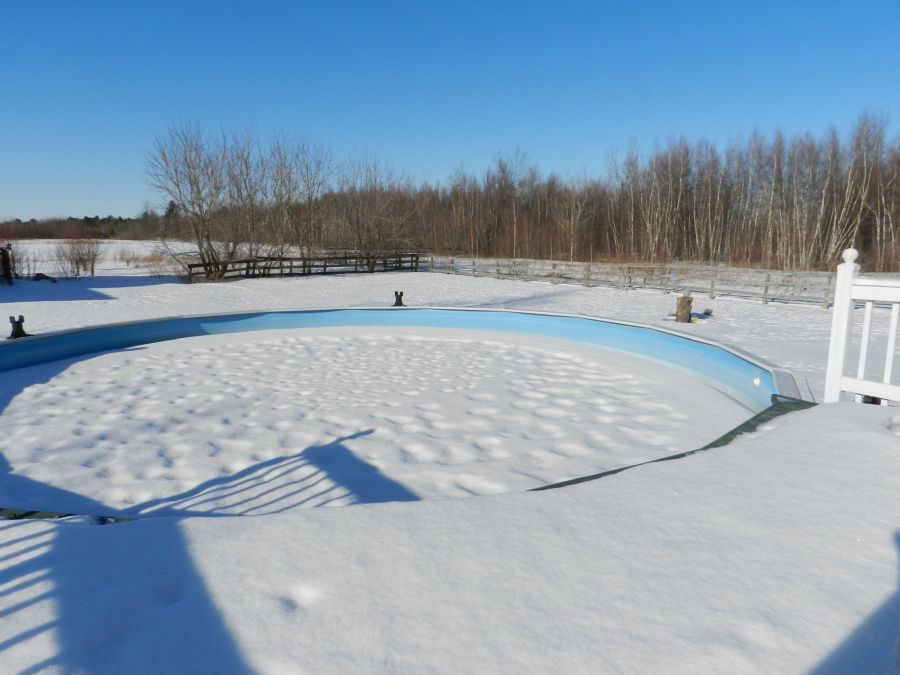Prepare your pool for the winter
Prepare your pool for the winter
Winter is around the corner, and of course, you are worried about winterizing all parts of your house. You are probably surfing the internet to research the easiest and simplest ways to winterize your home for the winter, especially your pool if you have one. In this blog post, I will share with you seven simple steps to winterize your pool for the winter.
Prepare your pool for the winter:
- Step 1: Clean your pool carefully
- Step 2: Check the chlorinator and the pump of your pool carefully
- Step 3: You must backwash the filter of your pool carefully
- Step 4: Balance the water in your pool
- Step 5: Remove the phosphate carefully
- Step 6: Use a solar pool cover
- Step 7: Drain the system

Scroll on to read the seven simple steps that will help you winterize your lovely pool for the chilly months, and also why you should not drain your pool completely for the winter.
Contents
- 1 Step 1: Clean your pool carefully:
- 2 Step 2: Check the chlorinator and the pump of your pool carefully:
- 3 Step 3: You must backwash the filter of your pool carefully:
- 4 Step 4: Balance the water in your pool:
- 5 Step 5: Remove the phosphate carefully:
- 6 Step 6: Use a solar pool cover:
- 7 Step 7: Drain the system:
- 8 Should I Drain the Pool during the Winter?
- 9 Final remarks
Step 1: Clean your pool carefully:
You must remember that if you ignore the mud, dust, bird droppings, dry leaves, dead insects, and twigs in your pool, they will turn into fungus and algae, which can be toxic for the health of your surroundings. A smelly and stinky pool will not only be unbearable throughout the chilly months, but it will also be unusable in the upcoming spring and summer seasons. Your pool always needs a lot of effort and time, and of course, it is an investment that you don't want to lose so easily.
First of all, you must carefully remove all the dust, dirt, and debris from the filters of your pool. If you are too busy or too lazy to do this task on your own, you must hire a professional pool expert for this task. Leaving the filters of your pool full of dirt, dust, and debris throughout the freezing months will make your pool unusable after winter and will require a lot more time, effort, and cost to clean.
After the filters of your pool are clean, neat, and tidy, focus on the pump basket of your pool. Take your time and carefully clean the pump basket. You must make sure that not a single grain of mud or sand is left near or around it.
When both the filter and the pump basket of your pool are neat, clean, and shining, focus on the skimmer of your pool and clean it carefully. You must remember that if you ignore a single grain of dirt, grease, or grime and let it sink to the bottom of your pool, it will turn into a greenery substance with an unpleasant odor. It will need a lot more effort and time to remove later on. You must make sure that the water in your pool is 100% non-toxic, 100% hygienic, and clear.
To thoroughly clean the bottom and equipment of your pool you will have to invest in a good quality brush and suction pipe.
Step 2: Check the chlorinator and the pump of your pool carefully:
You must carefully examine the chlorination cell of your swimming pool to see if there are any calcium deposits in it. Calcification or unwanted calcium deposits can ruin the health of the pump of your swimming pool which will need a lot more investment later on creating a hole in your wallet. When it comes to the thick layers of calcium carbonate that form sediments on your pool equipment or at the bottom of your pool, you must remember that a stitch in time saves nine.
You must remember that there are salt cell cleaners easily available in stores and online at affordable rates. Salt cell cleaners are very helpful to winterize your pool. If yours is a concrete pool, then you must make sure that the calcium hardness is always between 200 and 250 ppm.
If your pool is made out of vinyl, then you must make sure that its calcium hardness is always between 175 and 225 ppm. You must make sure that the free chlorine level in your pool is between 1 and 3 ppm (if you own any kind of pool). You must make sure that the free bromine level in your pool is between 3 and 5 ppm (if you own any kind of pool).
Step 3: You must backwash the filter of your pool carefully:
There are three types of filters used for pools. i) cartridge filter: This type of filter needs a lot of maintenance and cleaning throughout the swimming season and after you winterize your pool. It is really simple to clean the cartridge filter by just lifting its cartridge and adding some chemicals to remove the deposits of dust, rust, debris, and other contaminants found inside it.
ii) Diatomaceous earth filter: This type of filter is also very easy to clean and backwash. Whenever you notice that the pressure on the gauge of your filter has increased a lot and the flow of the water has decreased a lot, it is the proper time to clean and backwash your filter carefully. To backwash your filter, you must run the water in reverse to remove all of the wastewater.
iii) Sand filter: You must replace the old sand in your sand filter after three to five years depending on the frequency of use. After you backwash this type of filter, you must run it in normal rinse mode to resettle.
Step 4: Balance the water in your pool:
To balance the water in your pool you will have to carry out these 3 measures:
i) First of all, you must make sure that the ph level of your pool water is between 7.2 and 7.8. If you have a fiberglass pool, then you must make sure that the ph level is between 7.0 and 7.2. You must make sure that the alkalinity of your swimming pool is between 120 and 150 ppm.
ii) You must perform a chlorine shock test using chlorine shock tablets that are commercially available. You must add these tablets to the filter of your pool and the skimmers of your pool. After that, you must make sure that you run the filter and the skimmers of your pool for at least 6 to 12 hours.
iii) To prevent the outbreak of fungus, you must make sure that you use a reliable algicide. After adding the algicide, you must make sure that the filter of your pool is left to run for at least 6 to 12 hours.
Step 5: Remove the phosphate carefully:
You must add some phosphate remover to the water in your pool to eliminate the food source of algae. When you carefully remove all of the phosphates, you are a hundred percent sure that no algae will ever grow in the water of your pool throughout the winter months.
Step 6: Use a solar pool cover:
Firstly, a solar pool cover helps your pool retain the heat already in the water by eliminating evaporation. This is because solar pool covers are real physical barriers that sit on top of the water, thereby preventing the snowfall and the rainfall from directly falling into the water in your pool thus preventing raising its level and causing an unnecessary overflow. Some solar pool covers perform their function better than others.
Secondly, a solar pool cover acts as a magnifying glass to amplify the sun's rays. You must take off the summer pool cover and replace it with the winter pool cover. You must make sure that it has a lot of tension to prevent it from touching the surface of the water otherwise it will make the water dirty again.
If there is no fence around your swimming pool, you must make sure that you use a safety pool cover to prevent your kids and pets from walking over it to avoid the accident of drowning.
Step 7: Drain the system:
You must make sure that you drain every drop of water out of your pool heater, heat pump, filter, and pump. Make sure you get rid of excess water and lower the pool such that it is the skimmer level and jets, so you prevent the plumbing freezes. If some of the systems are inside in a heated environment, you don't have to drain them. You must remember that these equipment are really expensive and if you leave them full of water they will freeze and expand which will, of course, crack them and cause damage beyond repair.
Draining the system is a simple task because they have small drain plugs below them and you can easily open them on your own.
Should I Drain the Pool during the Winter?
No, you should not drain your pool during the winter. You should close the pool for the winter and winterize it correctly, but you should not drain the water completely. You should drain as much water, so all the equipment does not contain any water, and prevent the plumbing freezes.
Having water in your pool protects the pool liner or tiles against it against damage and cracks from debris or the winter weather. If you treat the water in the pool correctly, it is much easier to open the pool in the spring when the weather is getting better. If you have to refill the pool with new water, it would cost a lot of water.
If you maintain your pool correctly, you usually only have to drain it after 5 to 10 years completely.
Final remarks
To sum up this blog post, I would say that you must make sure that the equipment of your pool is working properly and is functional and usable for the next pool season. If you need any maintenance, repair, or if any part of it has any visible damage, you must seek professional assistance at once for the replacement and the maintenance of the pool equipment in a timely manner.
This will save you from a lot of stress the next time you want to make use of the pool.






